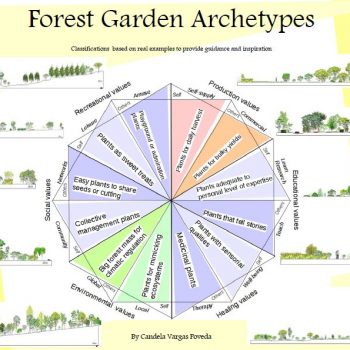Forest garden archetypes: classifications based on real examples to provide guidance and inspiration
| Autor(es) |
Vargas Poveda, Candela |
| Título
| Forest garden archetypes: classifications based on real examples to provide guidance and inspiration |
| Miniatura
|  |
| Fichero
| Forest Garden FGA-Booklet.-Annex-1 |
| Tipo de recurso |
Monografía |
| Resumen |
Los jardines forestales están ganando popularidad entre los agricultores, horticultores y el público en toda Europa.
Está claro que cada jardín forestal es único, diseñado en simpatía con su entorno y las necesidades, visiones y valores de su(s) creador(es). Como en cualquier sistema seminatural, la estrategia de gestión del sistema influirá en su aspecto, creando diferentes estructuras de paisaje, a partir de las cuales es posible identificar patrones generales. De esta manera es posible aplicar el pensamiento de patrones, un concepto que fue descrito por Christoper Alexander 1977 como "Cada patrón describe un problema que ocurre una y otra vez en nuestro entorno, y luego describe el núcleo de la solución de ese problema, de tal manera que se puede utilizar esta solución un millón de veces, sin tener que hacerlo de la misma manera dos veces".
El objetivo de este folleto es crear un conjunto de arquetipos simples de jardines forestales distinguiendo entre los diferentes objetivos que pueden tener los jardines forestales y cómo esto influye en la estructura específica de los jardines forestales y el sistema de gestión, utilizando los sitios en el Reino Unido como un sistema de estudio. Los arquetipos simplifican tanto las complejidades de los motivos de las personas como las cualidades visuales de los jardines forestales ingleses.
|
| Summary |
Forest gardens are now gaining popularity amongst farmers, horticulturalists and the public throughout Europe.
It is clear that each forest garden is unique, designed in sympathy with its environment and the needs, visions and values of the creator(s). As with any seminatural systems, the management strategy of the system will influence its appearance, creating different landscape structures, from which it is possible to identify general patterns. In this fashion it is possible to apply pattern thinking, a concept that was described by Christoper Alexander 1977 as ”Each pattern describes a problem which occurs over and over again in our environment, and then describes the core of the solution to that problem, in such a way that you can use this solution a million times over, without ever doing it the same way twice”.
The aim of this booklet is to create a set of simple forest garden archetypes by distinguishing between the different goals that forest gardens can have and how this influences the specific forest garden structure and management system, using sites in the UK as a study system. The archetypes simplify both the complexities of people's motives and the visual qualities of the English forest gardens. |
Warning: sizeof(): Parameter must be an array or an object that implements Countable in /var/www/vhosts/tierrasagroecologicas.es/httpdocs/conocimiento/wp-content/themes/agroecologia/single-item.php on line 356
| Palabras clave |
|
| Notas |
This booklet is a result from a multi-level Participatory Action Research involving experienced and new forest gardeners and researchers from England and Denmark. Therefore it has been possible thanks to the efforts of many people. First of all thanks to Cathrine Dolleris, from the Danish Permaculture association that secured me with funding for an Erasmus + internship in England from September 2015 – November 2015. |
